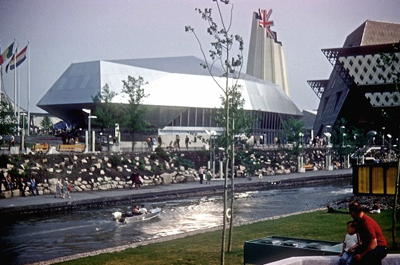
The
European Communities pavilion at Expo 67 was presented by the
European Common Market, the
Steel and Coal Community, and the
European Atomic Energy Community. These institutions promoted social and economic progress through joint action among its 6 member countries: Belgium, France, Germany, Italy, Luxembourg, and the Netherlands.
Located on Île Notre Dame near the
Expo-Express station and facing the
pavilion of
Germany, the steel-blue structure was reminiscent of a diamond, evoking the radiant multi-facets of the
European Community. Steel, one of Europe's first common market products, was used to emphasize this.

Inside, the pavilion sought to clear up the complexities of the
European Common Market (
E.C.M.) with a rundown of its institutions and its history. A spectacular mosaic map in the entrance hall helped illustrate this to visitors.

In a section called
"Europe Yesterday and Today", an antique tapestry and a modern nuclear research device were displayed side by side, symbolizing Europe's glorious past as well as its current and future progresses.
An exhibit entitled
"Six Countries Decide to Live Together" traced the
E.C.M.'s growth, from Winston Churchill's appeal in 1946 that France and Germany work together, through the 1957
Treaty of Rome, to modern day 1967; where 65 countries had appointed
diplomatic missions to the
E.C.M.'s Brussels headquarters.

Economics aside, a portion of the pavilion was dedicated to arts and culture. A section named
"The Great Europeans" payed tribute to 140 Europeans that had influenced western civilization in such disciplines as music, fine arts, literature, philosophy, science, technology and medicine.
Another section displayed 60 examples of contemporary art, selected by members of the 6
European Community countries. A catalogue of this collection was available for visitors to purchase.

A bookshop offered a wide range of publications concerning the various aspects of Europe. A record library allowed visitors to listen to masterpieces of European music either by loudspeaker system or by individual equipment. A non-stop film presentation enabled visitors to further acquaint themselves with the
E.C.M.'s principal activities.
The pavilion's restaurant offered a wide variety of European specialties, served on the visitor's choice of table service. Cheeses, fine cooked meats, pastries, etc. were sampled on Europe's finest china, while exquisite wines and liqueurs were sipped from Europe's most delicate crystal...
 images: (1) author's own(2 and 5) DC Hillier(3) flickr.com (magstb67)
images: (1) author's own(2 and 5) DC Hillier(3) flickr.com (magstb67)
(4) library and archives canada
(6) Bill Dutfield
 Small, medium, large: 3 convenient formats of fried chicken TV Dinners.
Small, medium, large: 3 convenient formats of fried chicken TV Dinners. Small, medium, large: 3 convenient formats of fried chicken TV Dinners.
Small, medium, large: 3 convenient formats of fried chicken TV Dinners.







